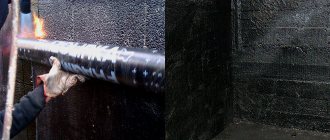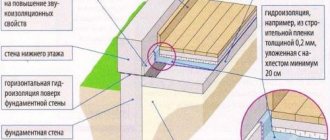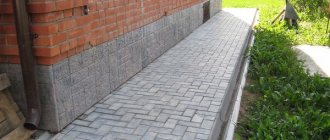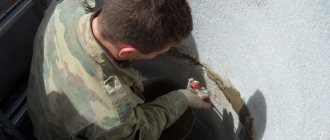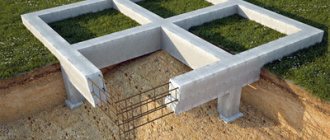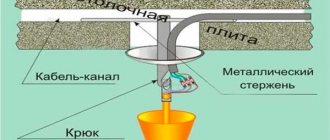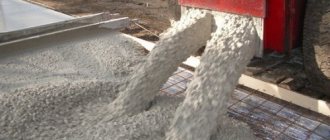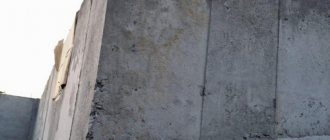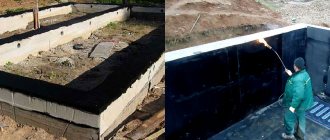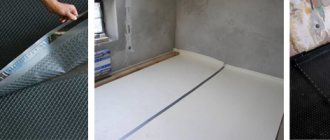Concrete, which is part of a monolithic foundation, has one unpleasant feature: when moisture gets on its surface, it plays the role of a sponge, absorbing water in significant volumes, therefore, in order to preserve the reinforcement frame and maintain optimal microclimate parameters in the basement (ground floor) foundation waterproofing is necessary. Of course, we are talking about low grades of concrete, for which the water resistance coefficient is low. With the addition of special waterproofing compounds (increasing the grade and, accordingly, the cost of the solution), the ability to absorb moisture decreases, but not every individual developer can afford to build a foundation on such an expensive material. For this simple reason, the issue of waterproofing the foundation is relevant: using special materials and compositions, you can protect the foundation from the harmful effects of moisture.
Advantages and disadvantages of winter filling
There is no need to talk about the advantages of pouring the foundation in winter. You can experience some benefit from such an event only if a third-party team is involved in the arrangement of the supporting structure. The point is this: in winter there are few orders and workers reduce the price, attracting the customer’s attention with tempting offers to pour the foundation in December-January in order to continue construction by March-April.
You can count on a favorable outcome of such an undertaking only if the customer hires a proven team with good reviews and appropriate qualifications. Otherwise, the imaginary savings will only result in even greater costs, because If the technology is violated, the concrete may not set and the foundation will simply disintegrate with the arrival of heat.
Winter foundation pouring
There are a lot of negative aspects associated with pouring the foundation in winter.
Firstly, the labor intensity of excavation work increases - it is unlikely that it will be possible to prepare a trench/pit in frozen soil conditions on your own. The only option is to resort to the use of special excavator equipment, which will not have the best effect on the final cost of the work.
Digging a trench in winter is not easy
Secondly, the efficiency of work performance is significantly reduced. Anyone who has at least once had to carry out certain construction activities in the cold season knows perfectly well how much more difficult it is to do the same work in winter than in warm weather.
Thirdly, total costs increase. This is justified by the simple fact that it is necessary to buy additional modifying additives that help increase the frost resistance of concrete and make pouring the foundation as such possible. Upon a cursory glance at the market situation, the price of modifiers may seem relatively insignificant. But it is important to understand that additives have to be used in large quantities, and the total cost of purchasing them will be very significant.
Currently reading
Two-story bathhouse project - Building a bathhouse or sauna
How to make lighting in a bathhouse
Antifreeze additives in concrete
Antifreeze additive in concrete
Thus, if the construction site is located outside of permafrost areas, and the deadline for completion of the work is not pressing, carefully weigh all the advantages and disadvantages of winter concreting before deciding to carry out such an event.
Video - Benefits of winter construction
Bitumen membranes
If you work with welded roll material during the cold season, you need to ensure that the temperature of the material itself is not less than the flexibility of the sealant. This data can be found on the packaging; it is indicated by the manufacturer.
In sub-zero weather, rolled materials should be kept at room temperature for at least a day before applying insulation. It is important that the temperature in the room does not fall below 15 degrees.
Weld-on seals should not be used during fog, rain, or when there is frost or frost on the concrete surface. In such weather conditions, the foundation must be dry and warm.
If weather conditions are unfavorable, then during waterproofing work you should use greenhouses or canopies, and provide the necessary conditions.
About frost-resistant additives
Concrete does not tolerate negative temperatures well - in such conditions the material is destroyed, because During freezing, the process of natural transformation of water from a liquid into a solid occurs, accompanied by an increase in volume and the injection of various internal forces and stresses. To level out the listed negative effects, additives are used that increase the frost resistance of concrete. The frost resistance indicator is determined mainly by the presence of pores in the concrete composition. These microscopic voids can contain ice without creating dangerous pressure on the material.
Concrete without frost-resistant additives
Concrete using frost-resistant additives
Additives containing surfactants are most effective. For example, the use of plasticizing additives such as SDB has a positive effect on frost resistance, because When using such modifiers, the formation of an optimal structure of the material is observed.
The use of plasticizing additives such as SDB has a positive effect on frost resistance indicators
In this case, optimal should be understood as a dense rather than microporous structure. It is with a dense structure that the setting of the cement paste slows down, which increases the likelihood of the maximum amount of cement entering into a reaction and, therefore, gives the concrete a chance to fully gain strength.
If necessary, special gas-forming additives can be included in the solutions. Their use leads to the formation of spherical micropores, which also contribute to increased frost resistance.
Plasticizer. Advantages: increase in the strength characteristics of concrete for ordinary materials by more than 15%, water resistance, frost resistance, corrosion resistance, surface quality
Important! You can count on the positive effect of using additives and modifiers only if you strictly follow the manufacturer’s instructions. If an insufficient amount of modifier is added to the solution, there will be no pronounced positive changes and the material will begin to freeze, and cement stone will never be able to form. With the arrival of heat, the cement hydration processes will be restored, but the structure of the mixture will be greatly changed, which will not have the best effect on the final strength of the supporting structure.
Photo of a foundation poured in winter
The procedure for using each modifying additive is determined in accordance with the manufacturer's instructions, but several general rules can be identified that remain relevant when using any modifier. Information about such recommendations is given in the table.
Table. Acceptable conditions for the use of modifying additives
| Conditions | Explanations |
| The amount of water in the concrete mixture | Almost all existing modifying additives make it possible to reduce the amount of water added to the solution. On average, savings remain at the level of 10-15%. Depending on the type of modifier, this indicator may vary - check the instructions individually. |
| Air temperature at the construction site | Certain temperature restrictions remain even if the concrete solution is prepared with the use of appropriate modifiers - you cannot build a foundation if the air temperature outside has dropped below -25 degrees (some additives can increase this figure to -35 degrees or more). |
| Air humidity at a construction site | Modifying additives lose their effectiveness when air humidity increases above the 60% mark. |
Important! When pouring a foundation in winter, the list of necessary additional measures is not limited to the use of modifiers. Concrete needs to be heated, thermally insulated, protected from external influences and a number of other actions aimed at maintaining a certain temperature of the finished structure - these points will be discussed individually in the appropriate section.
The list of existing modifying additives that increase the resistance of concrete to negative temperatures is impressive. Below you can read a brief description of the most popular and well-proven modifiers, but first be sure to study a few important notes regarding the correct use of additives.
Additive “Lignopan B-4” is an anti-frost-plasticizing additive (down to -18°C), allows concreting to be carried out at subzero temperatures, and reduces the consumption of mixing water by 5-10% for equally mobile mixtures
First, remember: the total costs of purchasing modifying additives will be very significant. Be careful and initially buy those modifiers that are designed for use in the conditions of your construction site.
Secondly, the rules for using different additives differ. Before using the modifier, be sure to study the manufacturer’s instructions to determine the required amount of the substance for a certain proportion of the solution.
Relative strength of concrete at different curing times at different temperatures
Strength of concrete depending on its age at the time of freezing
Minimum strength of concrete at the moment of freezing
Recommended content of antifreeze additives in concrete
Increasing the strength of concrete with antifreeze additives
Table. Popular modifying additives
| Additive name | Description |
| Accelerating antifreeze additive UPDM | A mixture containing production waste of the following ingredients in the specified proportions: — acetoacetic ether – 7 parts; — acetylacetone – 3 parts; — nitrochloractinide – 1 share. The finished solution has a dark brown color. The required amount of accelerating antifreeze additive varies between 100-420 ml per kilogram of added cement and is specified separately in accordance with the ambient temperature. |
| Sodium alcohol formate | The substance is classified as a by-product of petrochemical industry production processes. The color of the clear liquid can vary from soft straw to rich brown. The additive is added to the concrete mortar along with the mixing water. The required amount of modifier varies between 2-6% (determined, again, practically, in accordance with the ambient temperature). |
| Asol-K | Effective at temperatures down to -10 degrees. When used in warm weather, the modifier accelerates the setting of concrete. |
| Hydroconcrete – S-ZM-15 | At the same time, it increases the frost resistance and plasticity of concrete mixtures. It looks like a dark brown liquid solution. The modifier remains effective when used at temperatures down to -15 degrees. |
| Hydrozim | It is used at a temperature similar to the additive discussed above. Among the important advantages of Gidrozim, it is necessary to note the fact that upon contact with it, the reinforcing rods that are part of the concrete supporting structure do not rust. |
| Lignopan-4 | An additive that improves the frost resistance and plasticity of concrete. Effective when used down to -18 degrees. The required dosage varies between 2-4% and higher, depending on the air temperature at the construction site. |
| Sementol-B | Antifreeze that effectively manifests itself in the composition of concrete mixtures and solutions. The additive can be used at air temperatures up to +5 degrees, which significantly reduces freedom of action in winter, but it must be added in relatively small quantities - only 0.2-0.8% of the weight of cement. |
| Ammonia water | It is also an aqueous solution of ammonia gas. It is considered one of the most cost-effective modifying additives. It is characterized by a relatively low volumetric expansion rate, due to which the likelihood of various deformation processes occurring when pouring the foundation in winter is significantly reduced. |
Asol-K
Sodium alcohol formate
Hydroconcrete – S-ZM-15
Hydrozim
Lignopan-4
Sementol-B
Ammonia water is more often used than other additives in the winter installation of supporting structures and deserves separate consideration.
Ammonia water
Ammonia water (aqueous ammonia) – transportation
The concentration of the modifier, as before, is determined in accordance with the air temperature. Information on this matter is given in the table.
Table. Required concentration of ammonia water
As can be seen from the table, ammonia water remains effective even when used to prepare concrete mortar for pouring a foundation at temperatures below -35 degrees. This property is a great advantage of ammonia water over other modifiers, the conditions of use of which are limited on average to -15-25 degrees.
The use of ammonia water, unlike many other modifiers, eliminates the risk of corrosion of the reinforcing frame. The additive does not have a negative impact on the quality of adhesion of steel rods to the foundation concrete, does not violate the frost resistance of the structure, and does not form stains or efflorescence on the surface of the structure being equipped.
When using ammonia water, there is a certain slowdown in the setting time of concrete mixtures - the composition will remain convenient for laying for 4-7 hours.
Introduction of antifreeze additives
Prices for antifreeze additives for concrete
antifreeze additives for concrete
How to apply modifiers
When using modified additives, it is necessary to focus on some basic points:
— The use of frost-resistant substances allows you to reduce the amount of water consumed by 10-15% when making concrete mortar.
— The minimum temperature at which the use of modifiers is acceptable is 25 degrees below zero.
— When air humidity reaches 60%, the use of additives is prohibited.
— It is necessary to take into account factors in which individual components of modifiers interact with certain metals.
— The use of additives does not negate some additional measures when arranging the foundation during the cold period. When the air temperature is low, additives alone that affect the frost resistance of concrete are not enough. It is necessary to warm up the concrete and install additional thermal insulation to maintain a certain temperature of the finished structure.
Features of winter foundation pouring technology
To understand the peculiarities of pouring a concrete foundation at subzero temperatures, it is necessary to study the processes occurring in the solution under such conditions.
Features of winter foundation pouring technology
Hardening of concrete is associated with a hydration reaction. During its course, the interaction of cement minerals and water occurs, as a result of which new compounds arise. If dewatering of concrete occurs prematurely, the hardening process will slow down significantly or even stop completely, as a result of which the foundation will not achieve the required strength, will shrink and crack.
At subzero temperatures, water that does not have time to react with cement components turns into ice. Without modifying additives and other accompanying protection, the hydration reaction will not be completed, therefore, the concrete will not gain the required hardness. The result is a significant reduction in the strength of the supporting structure and its service life. The frozen water, along with this, increases in volume, which causes a decrease in the coefficient of adhesion of the concrete mixture to the reinforcing frame, which also threatens the destruction of the structure.
Winter pouring of foundations has many features
Considering the above, the distrust of most developers in winter pouring of the foundation becomes quite understandable. But if you approach the planned event wisely and knowledgeably, you can get a high-quality support base even at negative air temperatures. Moreover, in many cases this is the only possible solution.
Prices for cement-sand mixture
cement-sand mixture
Why waterproofing?
Mold on the walls, flooding and leaks on the floor are some of the negative factors encountered in the absence of proper insulation. Such a house is not suitable for storing food or any furnishings.
Only the use of high-quality materials and adherence to technology will ensure results when waterproofing the foundation, the price of which varies.
Waterproofing tasks are important:
- protection of basements and walls from moisture;
- prevention of distortions, crack formation;
- strengthening the foundation, extending service life thanks to the joint venture.
Ways to maintain normal concrete temperature
There are several ways to ensure the correct pouring of a high-quality, reliable and durable support base during the cold season. You are invited to familiarize yourself with each of them and choose the most optimal option specifically for your case.
Dense internal structure of high-quality monolithic concrete
Application of modifying additives
Detailed information about modifiers that increase the frost resistance of concrete mixtures was provided earlier. Information regarding concrete pouring as a technological process was discussed step by step in the corresponding publication. Below, only step-by-step recommendations will be given regarding ensuring the normal course of hardening processes and strength gain by concrete pouring in winter.
Before studying the instructions for preparing a concrete mixture for pouring a foundation, remember the following important rules:
- modifiers can be introduced either in the form of a powdered substance when mixing the dry components of the mixture, or in the form of a liquid by mixing with water before adding it to the solution. For recommendations on choosing a specific option, please refer to the instructions for the modifying additive used;
Introduction of additive into concrete truck
- the use of modifiers involves reducing the amount of water used by an average of 15-25%. The specific meaning should also be clarified individually in the instructions for the selected modifier.
In the context of private construction, it is more convenient to introduce the modifier into the water - there is no need to use dispensers, scales and other additional equipment used in industrial conditions in the process of preparing dry mixtures. And it is easier to achieve homogeneity of the solution when introducing a modifying additive into the water - a construction mixer or drill with an appropriate attachment will help with this.
Example of mixing concrete admixture
The procedure for preparing a concrete solution using modifying additives is not much different from the sequence for preparing a mixture for pouring without using them. Information on this matter is given in the table.
Table. Preparing concrete manually using modifiers
| Work stage | Description |
| Preparing the kit for work | Ideally, you need to purchase or at least temporarily use (you can try to negotiate with the nearest construction company) a concrete mixer. In the absence of one, you will have to work manually, and this, even in the case of a small foundation (for example, when laying an 80-centimeter support for a modest bathhouse measuring 3x4 m, you will need about 10 cubic meters of concrete), is long and labor-intensive. If you can’t get a concrete mixer, use a wide container, for example, a trough, as in the image, to mix the solution. Additionally you will need: a hoe, a shovel and a bucket. |
| Mixing dry ingredients | The dry components are mixed in the following proportions: for the share of cement (a material grade of at least M400 is used), 3 shares of sifted sand are added (it is best to use sand of different fractions, i.e. with sand grains of different sizes, which does not contain clay and organic impurities, ideal option - “enriched” mountain sand, if this is not available - washed river sand) and 5 shares of mixed-grade crushed stone without additional impurities. The components are thoroughly mixed with a hoe or other suitable device. |
| Mixing water and modifying additive | Traditionally, water is taken in an amount of 50% of the cement mass. When using modifying additives, as noted, the required amount of water can be reduced by 15-25% in relation to the standard recipe - this point, as well as the required proportion of the additive, is subject to individual clarification in the instructions for the selected modifier. The additive is added to the water, after which the components are mixed until homogeneous using a construction mixer or electric drill with an appropriate attachment. |
| Mixing dry and liquid ingredients | The liquid component is added to the dry mixture. Add water with a modifying additive and mix the solution thoroughly, trying to get rid of any lumps that have formed and ensure absolute homogeneity. A properly prepared concrete solution for pouring a foundation should slowly slide off the shovel without crumbling, spreading or delaminating. |
The sequence of preparing the solution in a concrete mixer is somewhat different from that discussed above.
Preparing the solution in a concrete mixer
First, water is poured into the container, after which the required amount of cement is added (in accordance with the recipe). Next, sand is added to the mixture and the components are thoroughly mixed for 3-4 minutes. The concrete mixer is turned off, a modifying additive is added to the container in the amount specified by the manufacturer, after which crushed stone is added to the mixture (the proportions were indicated earlier), and the components are mixed for at least 10 minutes. The output should be a homogeneous mixture of normal density.
Homogeneous mixture at the output
Ready-made concrete is used for its intended purpose. Links to relevant instructions have been provided previously. But the use of modifying additives alone, as noted, is not enough - additional measures must be taken to ensure thermal insulation and, if necessary, subsequent heating of the fill.
Important note! The use of anti-frost modifying additives makes it possible to pour a concrete foundation in the cold season, but it will still take much longer for the structure to harden and gain strength than in warm weather.
The gain of critical strength at subzero temperatures occurs on average per month. Upon reaching critical strength, concrete begins to gain design strength only after thawing. It will take 28 days to achieve the standard strength parameters of the structure. Thus, the positive temperature of the protected support base must be maintained even after concreting is completed.
How to properly pour a foundation in winter
Is it possible and is it worth doing? These questions often bother newcomers to construction. After all, it is very difficult to carry out any work in the cold; snow and frost can interfere. Expert advice will tell you how to properly fill the foundation in winter with your own hands. The rules of work are as follows:
— First of all, a trench or pit is dug, while the ground moisture that will collect at the bottom is controlled. At sub-zero temperatures, water freezes and ice forms, which must be removed, since nothing can be placed on such a base.
— Next, the concrete is mixed using the necessary modifiers and the mixture is heated to the desired temperature.
— The next step is the installation of formwork and a frame made of reinforcement. The formwork is filled with concrete mixture. The required positive temperature must be maintained for a certain period of time (to accelerate the setting process) using heating equipment. Immediately after pouring, the foundation can be insulated using roofing material or polyethylene film. You can sprinkle a layer of sawdust (20-30 cm) on top. As a result, we have a ready-made foundation in winter.
Is it possible to fill it for the winter? The answer is yes. But it is still recommended to build walls on such foundations at positive temperatures, since the concrete solution needs a certain time to acquire strength. By preparing the foundation in winter (taking into account all the rules and nuances), you can get a strong and durable structure.
20 photos of cats taken at the right moment Cats are amazing creatures, and perhaps everyone knows this. They are also incredibly photogenic and always know how to be in the right place at the right time.
Top 10 Broke Stars It turns out that sometimes even the biggest fame ends in failure, as is the case with these celebrities.
Our ancestors slept differently than we do. What are we doing wrong? It’s hard to believe, but scientists and many historians are inclined to believe that modern man sleeps completely differently than his ancient ancestors. Initially.
10 charming celebrity children who look completely different today Time flies, and one day little celebrities become adults who are no longer recognizable. Pretty boys and girls turn into...
Never do this in church! If you are not sure whether you are behaving correctly in church or not, then you are probably not acting as you should. Here's a list of terrible ones.
Unforgivable Movie Mistakes You Probably Never Noticed There are probably very few people who don't enjoy watching movies. However, even in the best cinema there are mistakes that the viewer can notice.
Foundation insulation
It is better to address the issue of organizing thermal insulation of concrete pouring at the stage of arranging the formwork. The technology consists of constructing a non-demountable structure from special polystyrene foam blocks instead of assembling traditional formwork from wooden boards.
This design looks like this:
Permanent formwork
Expanded polystyrene formwork
Photo of permanent formwork
Permanent formwork is elements of a building structure (blocks or panels) that are connected to each other according to the principle of a constructor
Blocks of various sizes are available on the market, which allows you to select suitable elements for constructing foundation formwork of any shape and size. The end parts of the blocks are equipped with grooves and serrated cutouts, the forces of which ensure fastening of the elements without the need to use third-party fasteners.
Cost of styroblock - permanent formwork made of polystyrene foam
An important advantage of this assembly method is the absence of gaps between the blocks, which guarantees the highest possible quality of thermal insulation and eliminates the need for additional sealing of joints.
Foundation formwork - elements
Expanded polystyrene is not afraid of moisture, which makes it possible to abandon the need for thorough waterproofing. At the same time, the material is not subject to rotting, so you don’t have to worry about the safety of the concrete pouring in contact with such permanent formwork.
Fixed formwork made of extruded polystyrene foam
The technology for arranging such insulation comes down to installing elements of permanent formwork in a dug pit/trench along the perimeter of the future support platform with their subsequent fastening using existing grooves and jagged cutouts.
Helpful advice! For installation in the corners of a trench, it is better to use corner blocks specially designed for this purpose.
The use of these eliminates the possibility of cracks forming in the formwork structure and deterioration of its thermal insulation characteristics.
Installation of permanent formwork
Corner dismountable permanent formwork module
Corner formwork block
Corner assembly option
Important! The load-bearing capacity of polystyrene foam formwork is limited - if it is used, only a light wooden bathhouse can be built on top of the finished foundation. Loads created by buildings made of bricks and building blocks will most likely lead to the destruction of polystyrene foam elements.
Additional aspects of foundation insulation were discussed in detail in the corresponding publication.
Reviews
I decided to build a greenhouse on my site for growing flowers. I really wanted my building to be ready for spring. While I was gathering equipment and building materials, clearing a place for construction, autumn came and I practically had no time left for construction. I read about the pile method of constructing a foundation in winter.
We suggest you familiarize yourself with Which insulation is better to choose for facade plaster and how to calculate the insulation thickness
I live in a region where spring is protracted and cold weather comes very early. Moreover, the nature of the soil is not particularly conducive to construction and requires a special approach. The neighbor advised building the foundation when frost sets in and the ground freezes significantly deep enough. That's what I did.
Of course, it took a lot of time and effort to dig the trench. And heating the foundation is very expensive. But when I calculated the result, I realized that I had not made a mistake in this matter, but only won. In early spring I continued to build my house, which I plan to finish by the fall. Sergey, Naryan-Mar
I had an argument with friends about building a foundation in the cold. Just when the opportunity came to prove that I was right, I started building a bathhouse. All work on the construction of the foundation was carried out in winter when it was frosty. I used the technology as written. Heating, canopy, thermal insulation - I used everything. The bathhouse has been standing for two years now and has not shown a single shrinkage or crack. It turned out that it turned out to be more profitable for me to build a foundation in the winter. Nikolay, Nizhny Novgorod.
Construction of a canopy over the foundation
To ensure protection of the concrete base from snow and cold air masses, a tent-type canopy is constructed. A car awning or an ordinary tarpaulin are well suited as a protective material - they are characterized by high water-repellent properties and are strong enough to withstand the loads typical of the cold season.
This design will look something like this.
Construction of a canopy over the foundation
In the photo, a full-fledged frame was built with vertical posts, horizontal cross members and even improvised rafters to support the tarpaulin roof.
Experts recommend taking the time to build just such a reliable frame. Moreover, when arranging the foundation for a private bathhouse, this will not take much effort and time. And in your case, with a high degree of probability, internal vertical supports will not be needed - the need to use them arises only when arranging large-scale support structures.
For vertical supports, you can use a beam with a section of 10x10 cm or 10x15 cm. Make horizontal crossbars and rafters from wooden boards 3-4 cm thick.
The procedure is as follows:
Construction of a canopy frame
Awning on a frame
Foundation under a canopy
Helpful advice! For external cladding, use a tarpaulin 20-30 cm longer than the height of the walls. You will press the free part of the material below to the ground, placing bricks, building blocks and other suitable elements on top. Thanks to this, the ventilation of the finished structure will be minimized.
An even simpler option for arranging a protective shelter, perfect for isolating small support areas, is discussed in detail in the section “Foundation in 20 days: video selection” in the corresponding lesson.
What affects the installation of waterproofing?
Usually the final decision depends on several factors. Among them are soil heterogeneity, conditions for operating the house, soil expansion due to frost, and the height of groundwater flow.
Types of foundation installation
With a tape, the location of the main elements is at depth. The load is evenly distributed over the entire surface due to the support of the canvas on the foundation slabs.
Pile foundations are the most budget-friendly and affordable. Guarantees a minimum cost of materials per 1 square meter. These are separate pillars for buildings that do not require continuous support.
There are also reinforced concrete slabs, also used as foundations. Only the layer of soil at the top is removed; there is no need to dig pits.
Surface water level
Here are the recommendations:
- coating and horizontal roofing felt cope with groundwater located at a distance of up to 1 meter from the foundation;
- a drainage system is added when groundwater is higher than the base of the foundation or basement floor. The price remains affordable.
Waterproofing is recommended to be carried out at the initial stages of installation.
How to protect an already poured foundation?
Protection methods have also been developed for buildings that have already been built.
Conventional mastic does not always work; preference is given to:
- leaf products;
- roll
Self-adhesive materials will also be optimal; it’s easy to make protection from them.
Organization of additional heating of the foundation
In combination with the protective tent discussed above, special equipment works well, allowing you to maintain the temperature inside the tent at a higher level compared to outside.
Heat gun
The simplest and most convenient option for such equipment is a gas-powered heat gun. This system looks like this:
Gas fired heat gun
Gas heat guns are autonomous air heating equipment that is used for quick and efficient heat distribution
A heat gun works on the principle of a conventional heater:
The use of a heat gun has a significant drawback - its operation is inevitably accompanied by relatively large financial costs.
Heat gun on a construction site
For example, using a 10-kilowatt unit allows you to increase the air temperature inside a 100 m2 tent by a maximum of 10 degrees compared to the outside temperature. Under such conditions, the gun will burn up to 20 liters of gas during the day.
If the street is colder than -15 degrees, you will have to use a gun with a power of about 30 kW to heat the area of the specified area. At the same time, gas consumption will triple. In monetary terms, the costs will be about 1000 rubles per day. Using the given data, you can calculate the cost of heating the support base in your case.
Gas heat gun Kraton Heat gun, 30 kW
Gun characteristics
Whether such financial investments are advisable or whether it is better to wait for the onset of warmer weather - each developer must make a decision on this issue independently.
A good alternative to a heat gun is a special transformer designed to heat concrete structures.
Transformer station KTPTO-80 is designed for heating concrete and monolithic structures
Transformer open
Important! Do not try to connect the transformer yourself without the appropriate skills and qualifications - this is life-threatening. It is better to initially contact an experienced specialist and protect yourself from possible tragic consequences.
The electrodes are connected at one end to the transformer, at the other end to the fittings in increments of about half a meter. A qualified technician must be involved in such work, capable of correctly installing the electric heating system and ensuring control of its functioning in the future.
An example of heating a stove. Heating cables are laid between the fittings
Any errors when using a transformer can lead to electric shock to foundation workers. To minimize risks, 36-volt equipment is used.
Heat gun prices
heat gun
Cement-based substance
Installation of waterproofing can be carried out at a temperature of at least +5 °C. If the ambient temperature is less than 5 °C, insulation can be carried out provided that the concrete surface is heated to +5 or by installing greenhouses or a heat gun.
To knead a solution of the correct consistency, water should be added to it at a temperature of about 20 degrees.
Cement-based coating insulation can be used on both wet and dry surfaces.
Summing up
The conclusion from all of the above is the following: concrete can be poured in winter, but only if there is a justified need, because this technology has a number of disadvantages.
If preference is given to winter concreting solely because of the developer’s desire to save on the services of third-party workers, you need to think several times, because As a result, imaginary savings can result in additional costs when carrying out excavation work, insulation, construction of a protective shelter and organizing heating.
Concreting in the summer takes much less time, labor and financial resources. If pouring the foundation in winter is the only possible option, carry out the work in strict accordance with the recommendations received.
Bentonite base
You can resort to this base for waterproofing the foundation at any time of the year. Of all the bases presented above, this one is the most frost-resistant. It can be used even at -20 °C, as well as at high humidity levels. This composite is also called “bentonite mats”. You can lay them on a previously prepared surface; it does not matter whether it is dry or wet, the main thing is that there is no water on it.
Mats can also be laid on a frozen surface (however, there should be no ice or snow on it).
The technology for laying mats does not provide for their installation in foggy, rainy and very windy weather.
If there is a long break in construction work, the laid mats should be covered with polyethylene or other protective material.
Foundation in 20 days: video compilation
For a better understanding of the process, we invite you to watch a video collection that step by step illustrates the process of independently arranging the foundation.
The first day. Marking
Second day. Excavation
Day three or four. From cushion to reinforcement
Day five or six. Continuation of arrangement of internal layers
Day seven-eight. Important waterproofing issues
Day nine-ten. Learning to work with a level
Day 11-14. Making a greenhouse
Day 15-20. Finishing the job
Self-waterproofing of the base
When protecting the foundation from the harmful effects of moisture, do not forget about waterproofing the base, which can also be done with your own hands, without the involvement of qualified specialists.
The basement will have to be insulated up to the first floor of the house from the outside, since in winter snow accumulates on the blind areas, which melts as the temperature rises, and then penetrates with water into the foundation and basement of the building.
To prevent such penetration, the plinth must be provided with internal and external waterproofing. Moreover, for the exterior cladding it is necessary to use high-quality waterproofing materials that are resistant to low temperatures and temperature changes.
In general, the quality of any waterproofing directly depends on the materials with which it is constructed. They, coupled with strict adherence to the chosen technology, are the guarantor of reliable protection from water of any premises of a private house or city apartment.
One thing is obvious: if a private mansion has a heated basement, steam and waterproofing of both the foundation and the basement are simply necessary, regardless of the grade and frost resistance of the concrete used for the construction of the structures. If you don’t take care of waterproofing right away, then (after flooding and all the “pleasures” associated with it) you will still have to do it, but spending much more money, time and effort.
( 86 votes, average: 4.70 out of 5)
DIY smokehouse
Bituminous shingles - material features, do-it-yourself installation
